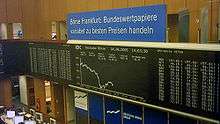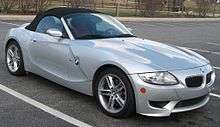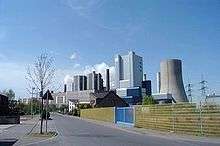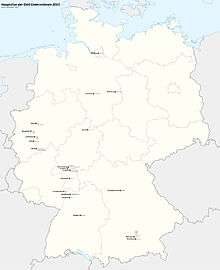DAX
The DAX (Deutscher Aktienindex (German stock index)) is a blue chip stock market index consisting of the 30 major German companies trading on the Frankfurt Stock Exchange. Prices are taken from the Xetra trading venue. According to Deutsche Börse, the operator of Xetra, DAX measures the performance of the Prime Standard’s 30 largest German companies in terms of order book volume and market capitalization.[2] It is the equivalent of the FT 30 and the Dow Jones Industrial Average, and because of its small selection it does not necessarily represent the vitality of the economy as whole.
 | |
| Foundation | 1 July 1988 |
|---|---|
| Operator | Deutsche Börse |
| Exchanges | Frankfurt Stock Exchange |
| Constituents | 30 |
| Type | Large cap |
| Market cap | €971.8 billion (Feb 28, 2017)[1] |
| Weighting method | Capitalization-weighted |
| Related indices | MDAX, SDAX, TecDAX, ÖkoDAX |
| Website | DAX homepage |
The L-DAX Index is an indicator of the German benchmark DAX index's performance after the Xetra trading venue closes based on the floor trading at the Börse Frankfurt trading venue. The L-DAX Index basis is the "floor" trade (Parketthandel) at the Frankfurt stock exchange; it is computed daily between 08:00 and 17:45 Hours CET. The L/E-DAX index (Late/Early DAX) is calculated from 17:45 to 20:00 CET and from 08:00 to 09:00 CET. The Eurex, a European electronic futures and options exchange based in Zürich, Switzerland with a subsidiary in Frankfurt, Germany, offers options (ODAX) and Futures (FDAX) on the DAX from 08:00 to 22:00 CET.
The Base date for the DAX is 30 December 1987, and it was started from a base value of 1,000. The Xetra technology calculates the index every 1 second since 1 January 2006.
Versions
The DAX has two versions, called performance index and price index, depending on whether dividends are counted. The performance index, which measures total return, is the more commonly quoted, however the price index is more similar to commonly quoted indexes in other countries. There are two versions of futures contract available: FDAX (€25 per point) and FDXM (otherwise known as FDAX mini at €5 per point).[3]
Price history
On March 16, 2015, the performance index first closed above 12,000.[4] On April 10, 2015, the price index first closed above its closing high from 2000.
Record values
| Category | All-time highs | |
|---|---|---|
| Closing | 13,783.89 | Monday, February 17, 2020 |
| Intraday | 13,795.24 | Monday, February 17, 2020 |
Annual returns
The following table shows the annual development of the DAX, calculated retroactively up to 1950.[5][6]
| Year | Closing level | Change in Index in Points |
Change in Index in % |
|---|---|---|---|
| 1950 | 30.18 | −2.42 | −7.42 |
| 1951 | 65.01 | 34.83 | 115.41 |
| 1952 | 59.75 | −5.26 | −8.09 |
| 1953 | 74.09 | 14.34 | 24.00 |
| 1954 | 135.28 | 61.19 | 82.59 |
| 1955 | 148.81 | 13.53 | 10.00 |
| 1956 | 137.80 | −11.01 | −7.40 |
| 1957 | 144.97 | 7.17 | 5.20 |
| 1958 | 232.23 | 87.26 | 60.19 |
| 1959 | 417.79 | 185.56 | 79.90 |
| 1960 | 534.09 | 116.30 | 27.84 |
| 1961 | 489.79 | −44.30 | −8.29 |
| 1962 | 386.32 | −103.47 | −21.13 |
| 1963 | 438.95 | 52.63 | 13.62 |
| 1964 | 477.89 | 38.94 | 8.87 |
| 1965 | 422.36 | −55.53 | −11.62 |
| 1966 | 333.36 | −89.00 | −21.07 |
| 1967 | 503.22 | 169.86 | 50.95 |
| 1968 | 555.62 | 52.40 | 10.41 |
| 1969 | 622.38 | 66.76 | 12.02 |
| 1970 | 443.86 | −178.52 | −28.68 |
| 1971 | 473.46 | 29.60 | 6.67 |
| 1972 | 536.36 | 62.90 | 13.29 |
| 1973 | 403.88 | −132.48 | −24.70 |
| 1974 | 401.79 | −2.09 | −0.52 |
| 1975 | 563.25 | 161.46 | 40.19 |
| 1976 | 509.02 | −54.23 | −9.63 |
| 1977 | 549.34 | 40.32 | 7.92 |
| 1978 | 575.15 | 25.81 | 4.70 |
| 1979 | 497.79 | −77.36 | −13.45 |
| 1980 | 480.92 | −16.87 | −3.39 |
| 1981 | 490.39 | 9.47 | 1.97 |
| 1982 | 552.77 | 62.38 | 12.72 |
| 1983 | 773.95 | 221.18 | 40.01 |
| 1984 | 820.91 | 46.96 | 6.07 |
| 1985 | 1,366.23 | 545.32 | 66.43 |
| 1986 | 1,432.25 | 66.02 | 4.83 |
| 1987 | 1,000.00 | −432.25 | −30.18 |
| 1988 | 1,327.87 | 327.87 | 32.79 |
| 1989 | 1,790.37 | 462.50 | 34.83 |
| 1990 | 1,398.23 | −392.14 | −21.90 |
| 1991 | 1,577.98 | 179.75 | 12.86 |
| 1992 | 1,545.05 | −32.93 | −2.09 |
| 1993 | 2,266.68 | 721.63 | 46.71 |
| 1994 | 2,106.58 | −160.10 | −7.06 |
| 1995 | 2,253.88 | 147.30 | 6.99 |
| 1996 | 2,888.69 | 634.81 | 28.17 |
| 1997 | 4,249.69 | 1,361.00 | 47.11 |
| 1998 | 5,002.39 | 752.70 | 17.71 |
| 1999 | 6,958.14 | 1,955.75 | 39.10 |
| 2000 | 6,433.61 | −524.53 | −7.54 |
| 2001 | 5,160.10 | −1,273.51 | −19.79 |
| 2002 | 2,892.63 | −2,267.47 | −43.94 |
| 2003 | 3,965.16 | 1,072.53 | 37.08 |
| 2004 | 4,256.08 | 290.92 | 7.34 |
| 2005 | 5,408.26 | 1,152.18 | 27.07 |
| 2006 | 6,596.92 | 1,188.66 | 21.98 |
| 2007 | 8,067.32 | 1,470.40 | 22.29 |
| 2008 | 4,810.20 | −3,257.12 | −40.37 |
| 2009 | 5,957.43 | 1,147.23 | 23.85 |
| 2010 | 6,914.19 | 956.76 | 16.06 |
| 2011 | 5,898.35 | −1,015.84 | −14.69 |
| 2012 | 7,612.39 | 1,714.04 | 29.06 |
| 2013 | 9,552.16 | 1,939.77 | 24.77 |
| 2014 | 9,805.55 | 253.39 | 2.65 |
| 2015 | 10,743.01 | 937.46 | 9.56 |
| 2016 | 11,481.06 | 738.05 | 6.87 |
| 2017 | 12,917.64 | 1,436.58 | 12.51 |
| 2018 | 10,558.96 | −2,358.68 | −18.26 |
| 2019 | 13,249.01 | 2,690.05 | 25.48 |
Components
Below is the list of companies which are a component of the DAX 30, as of 2019. The current stock prices and list of DAX companies are available from financial websites.[7][8]
| Company | Prime Standard industry group | Ticker symbol | Index weighting (%)1 | Employees | Founded | |
|---|---|---|---|---|---|---|
| Adidas | Clothing | ADS | 3.54 | 57,016 (2018) | 1924 | |
| Allianz | Insurance | ALV | 7.81 | 142,460 (2018) | 1890 | |
| BASF | Chemicals | BAS | 7.98 | 122,404 (2018) | 1865 | |
| Bayer | Pharmaceuticals and chemicals | BAYN | 8.27 | 110,838 (2018) | 1863 | |
| Beiersdorf | Consumer goods and chemicals | BEI | 0.95 | 20,059 (2018) | 1882 | |
| BMW | Manufacturing | BMW | 2.75 | 134,682 (2018) | 1916 | |
| Continental | Manufacturing | CON | 2.38 | 243,226 (2018) | 1871 | |
| Covestro | Chemicals | 1COV | 1.28 | 16,770 (2018) | 2015 | |
| Daimler | Manufacturing | DAI | 5.62 | 298,683 (2018) | 1926 | |
| Deutsche Bank | Banking | DBK | 1.73 | 91,463 (2019) | 1870 | |
| Deutsche Börse | Securities | DB1 | 2.10 | 5,964 (2018) | 1992 | |
| Deutsche Lufthansa | Transport Aviation | LHA | 1.07 | 135,534 (2018) | 1953 | |
| Deutsche Post | Logistics | DPW | 2.82 | 547,459 (2018) | 1995 | |
| Deutsche Telekom | Communications | DTE | 4.47 | 215,675 (2018) | 1995 | |
| E.ON | Energy | EOAN | 2.03 | 43,302 (2018) | 2000 | |
| Fresenius | Medical | FRE | 2.77 | 276,750 (2018) | 1912 | |
| Fresenius Medical Care | Medical | FME | 1.80 | 118,308 (2018) | 1996 | |
| HeidelbergCement | Building | HEI | 1.11 | 57,939 (2018) | 1874 | |
| Henkel | Consumer goods and chemicals | HEN3 | 1.88 | 53,450 (2018) | 1876 | |
| Infineon Technologies | Semiconductors | IFX | 2.72 | 40,100 (2018) | 1999 | |
| Linde | Industrial gases | LIN | 3.49 | 58,000 (2018) | 1879 | |
| Merck | Pharmaceuticals | MRK | 1.06 | 51,713 (2018) | 1668 | |
 | MTU Aero Engines | Aerospace | MTX | 1934 | ||
| Munich Re | Insurance | MUV2 | 2.72 | 41,410 (2018) | 1880 | |
| RWE | Energy | RWE | 1.07 | 17,748 (2018) | 1898 | |
| SAP | Software | SAP | 10.56 | 96,498 (2018) | 1972 | |
| Siemens | Industrial, electronics | SIE | 9.34 | 379,000 (2018) | 1847 | |
| Volkswagen Group | Manufacturing | VOW3 | 2.88 | 302,554 (2018) | 1937 | |
| Vonovia | Real estate | VNA | 1.85 | 9,923 (2018) | 2001 | |
| Wirecard | Financial Technology | WDI | 0.85 | 4,989 (2018) | 1999 |
^Note 1 : Weightings as at 27 December 2018 (remained unchanged from the previous quarterly review[9]). Source: de:DAX.
Former DAX components
This table lists former DAX components and the companies which replaced them.
| Date | Component excluded | Component included | Reason for exclusion/ Comments |
|---|---|---|---|
| 03.09.1990 | Feldmühle Nobel | Metallgesellschaft | Takeover of Feldmühle Nobel by Stora Enso |
| Nixdorf Germany | Preussag (now TUI) | Merged with Siemens to form Siemens-Nixdorf | |
| 18.09.1995 | Deutsche Babcock | SAP | Replaced by SAP because of lower market capitalisation |
| 22.07.1996 | Kaufhof | METRO | Merger of Kaufhof and Metro Cash & Carry |
| 23.09.1996 | Continental | Münchener Rück | Continental was added back to the DAX on 22 September 2003, though it was demoted again in 2008 and added back again in 2012 |
| 18.11.1996 | Metallgesellschaft | Deutsche Telekom | IPO of Deutsche Telekom |
| 22.06.1998 | Bayerische Hypotheken- und Wechselbank |
adidas | Merger of Vereinsbank and Hypobank to form HypoVereinsbank |
| Bayerische Vereinsbank | HypoVereinsbank | ||
| 21.12.1998 | Daimler-Benz | DaimlerChrysler (now Daimler) |
Merger of Daimler-Benz with Chrysler |
| 22.03.1999 | Degussa | Degussa-Hüls | Merger of Degussa AG with Hüls AG and renaming to Degussa-Hüls AG |
| 25.03.1999 | Thyssen | ThyssenKrupp | Merger of Thyssen and Krupp |
| 20.09.1999 | Hoechst | Fresenius Medical Care | Merger of Hoechst and Rhône-Poulenc with Aventis |
| 14.02.2000 | Mannesmann | Epcos | Takeover of Mannesmann by Vodafone |
| 19.06.2000 | Veba | E.ON | Merger of Veba and Viag to form E.ON |
| VIAG | Infineon | ||
| 18.12.2000 | Degussa-Hüls | Degussa | Merger of Degussa-Hüls AG and SKW Trostberg AG to new Degussa AG |
| 19.03.2001 | KarstadtQuelle | Deutsche Post | IPO of Deutsche Post |
| 23.07.2001 | Dresdner Bank | MLP Vz. | Takeover of Dresdner Bank by Allianz |
| 23.09.2002 | Degussa | Altana | Inadequate market capitalisation |
| 23.12.2002 | Epcos | Deutsche Börse | Fast-exit of Epcos, as Epcos' market capitalisation became inadequate.[10] |
| 22.09.2003 | MLP | Continental | Inadequate free float and market capitalisation. |
| 31.01.2005 | Lanxess | Lanxess was spun off from Bayer. It was added to the DAX in 2012 and removed in 2015. | |
| 01.02.2005 | Lanxess | ||
| 19.12.2005 | HypoVereinsbank | Hypo Real Estate | Takeover of HypoVereinsbank by UniCredit |
| 18.09.2006 | Schering | Postbank | Takeover of Schering by Bayer |
| 18.06.2007 | Altana | Merck | After the sale of Nycomed, inadequate market capitalisation[11] |
| 22.09.2008 | TUI | K+S | Fast-entry of K+S, inadequate market capitalisation of TUI[12] |
| 22.12.2008 | Continental | Beiersdorf | Fast-exit of Continental because of inadequate free-float market capitalisation after the acquisition by Schaeffler Group |
| 22.12.2008 | Hypo Real Estate | Salzgitter | Fast-exit of Hypo Real Estate because of inadequate free-float market capitalisation after a stake by American investor JC Flowers, as well as huge decline in market capitalisation during the Financial crisis of 2007–2010 |
| 23.03.2009 | Deutsche Postbank | Hannover Re | Fast-exit due to inadequate market capitalisation[13] |
| Infineon Technologies | Fresenius Vz | ||
| 21.09.2009 | Hannover Re | Infineon Technologies | Inadequate market capitalisation |
| 21.06.2010 | Salzgitter | HeidelbergCement | Inadequate market capitalisation |
| 24.09.2012 | MAN | Continental | Inadequate free-float capitalisation after acquisition by Volkswagen |
| 24.09.2012 | Metro | Lanxess | Inadequate market capitalisation |
| 21.09.2015 | Lanxess | Vonovia | Inadequate market capitalisation |
| 21.03.2016 | K+S | ProSiebenSat.1 Media | Inadequate market capitalisation |
| 19.03.2018 | ProSiebenSat.1 Media | Covestro | Inadequate market capitalisation |
| 24.09.2018 | Commerzbank | Wirecard | Inadequate market capitalisation |
| 04.09.2019 | ThyssenKrupp | MTU Aero Engines | Inadequate market capitalisation |





See also
- List of largest German companies
- CDAX, every listed German company
- HDAX, union of DAX, MDAX and TecDAX (successor to DAX 100, and equivalent of the FTSE 100 or the S&P 100)
- MDAX, the next 60 companies after the DAX
- SDAX, the next 70 companies after the MDAX
- ÖkoDAX, top 10 companies in renewable energy
- TecDAX, top 30 companies trading in the "new economy"
References
- "EQUITY INDEX DAX® INDEX" (PDF). Deutsche Börse. 28 February 2017. Archived from the original (PDF) on 6 September 2017. Retrieved 7 May 2017.
- DAX
- "TheDaxTrader - The German Dax details". Archived from the original on 11 July 2018.
- Dax breaks 12,000 barrier - FT.com
- "Index DAX (846900) | Indexstand | Börsenkurs | Kurs | Tool - boerse.de". web.archive.org. 19 October 2010. Retrieved 20 January 2020.
- DAX. "DAX Digital | DAX® (TR) EUR". dax-indices.com. Retrieved 20 January 2020.
- "DAX 30 Liste | DAX Werte | DAX Aktien". finanzen.net (in German). Retrieved 24 September 2019.
- "DAX 30 Liste: Dax Realtime-Kursliste | DAX Aktien | DAX Werte | Dax Unternehmen". boerse.de (in German). Retrieved 24 September 2019.
- "Carl Zeiss Meditec AG to be included in MDAX". deutsche-boerse.com. 5 December 2018. Archived from the original on 27 December 2018. Retrieved 27 December 2018.
- Deutsche Börse: Deutsche Börse ab dem 23. Dezember im DAX Archived 11 January 2009 at the Wayback Machine Pressemitteilung, 12. November 2002
- Frankfurter Allgemeine Zeitung: Merck ersetzt Altana im DAX
- Deutsche Börse: K+S ersetzt TUI in DAX Archived 11 January 2009 at the Wayback Machine Pressemitteilung, 3 September 2008
- Deutsche Börse - Pressemitteilung, 18 March 2009